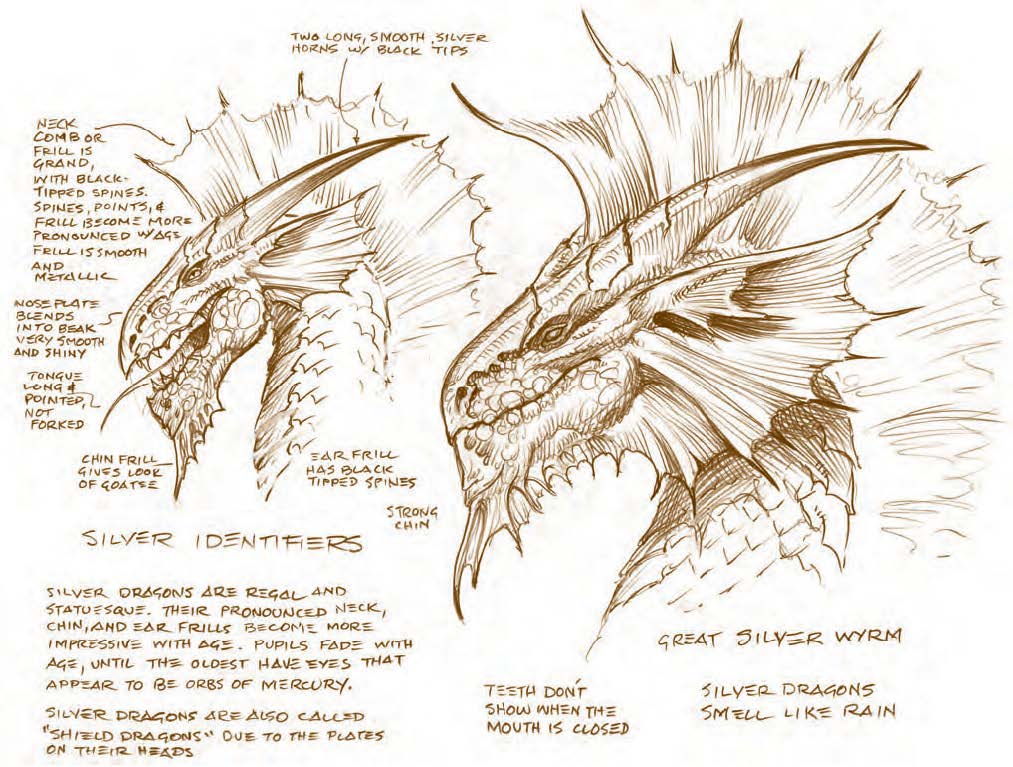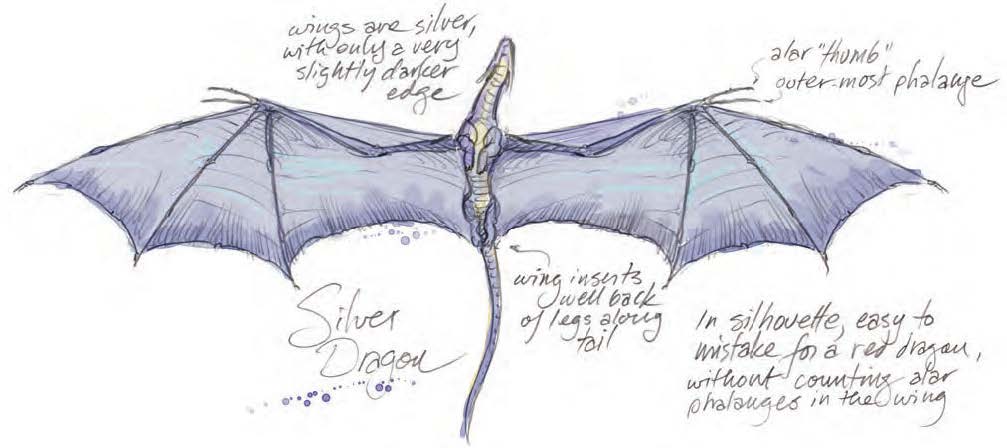Silver Dragon
Silver dragons enjoy the company of humanoids and often take the form of kindly old men or fair damsels. They cheerfully assist good creatures in genuine need, but usually avoid interfering with other creatures until their assistance is requested or until inaction would allow something evil to come to pass. They hate injustice and cruelty, though they concern themselves less with punishing or rooting out evildoers than with protecting the innocent and healing their hurts.
Though they can be found nearly anywhere, silver dragons love high mountains and vast, open skies with billowing clouds. They enjoy flying and sometimes soar for hours just for the pleasure of it.
Silver and red dragons often come into conflict. This is only partly because they lair in similar territories. Silver dragons despise red dragons for their love of carnage and penchant for destruction. Duels between the two varieties are furious and deadly, but silver dragons generally get the upper hand, usually by working together against their foes, and often by accepting assistance from nondragons.
Silver dragons prefer aerial lairs on secluded mountain peaks or amid the clouds themselves. A cloud lair always has an enchanted area with a solid floor for laying eggs and storing treasure.
Silver dragons often dwell in towns or in dungeons. When doing so, they typically take a humanoid form and blend in with the rest of the population. They always situate themselves near one or more open areas where they have space to assume their true forms when necessary.
Silver Dragon Identifiers
A silver dragon in its true form can be recognized by the smooth, shiny plate that forms its face. The dragon also has a frill that rises high over its head and continues down the neck and back to the tip of the tail. A silver dragon has the tallest frill of any metallic or chromatic dragon. Long spines with dark tips support the frill. The dragon also has ear frills with similar spines. It has two smooth, shiny horns, also with dark tips. A silver dragon has a beaklike nose and a strong chin with a dangling frill that some observers say looks like a goatee. It has a pointed tongue. A silver wyrmling’s scales are blue-gray with silver highlights. As the dragon approaches adulthood, its color slowly brightens until the individual scales are scarcely visible. From a distance, these dragons look as if they have been sculpted from pure metal. As a silver dragon grows older, its pupils fade until in the oldest the eyes resemble orbs of mercury. A silver dragon carries the scent of rain about it. When viewed from below, a flying silver dragon shows a remarkably similar profile to a red dragon. It has long wings that are broadest along the trailing edge. The wing membrane attaches to the dragon’s body behind the rear legs and well down the tail, and the head has clearly visible horns. The wings also show darker markings along the trailing edges, just as a red dragon’s do. Fortunately, a silver dragon has one minor feature that sets it apart from a red dragon: The outer alar phalange forms a second “thumb” at the leading edge of the each wing. Viewers unable to discern the dragon’s color would do well to look for this vital detail.Habits
A silver dragon often assumes a humanoid from, usually appearing as a kindly old human or a comely young elf, and spends most of its time in that form. Silver dragons do so to more readily associate with humanoids. Some scholars maintain that silver dragons prefer the company of humans or elves to that of other silver dragons. As with most things draconic, the truth is more complex than that. Silver dragons believe themselves to be superior to most other beings, just as other kinds of dragons do. Unlike other dragons, however, silvers believe that being a dragon imposes some limitations. Many of these are practical in nature, such as their massive size and the huge living space requirements that go along with it. What concerns silver dragons the most, however, is the draconic sense of time. They’re happy to live more than 2,000 years, but they constantly fight their tendency to reflect on things and let opportunities pass them by. They understand that short-lived races such as humans must seize every opportunity that comes their way, which gives them a drive toward accomplishment that most dragons lack. Silver dragons seek to couple their own long perspective on the world with humanity’s dynamism. It’s a lesson silver dragons believe other dragons would do well to learn. Though lawful and good, silver dragons have no great love for hierarchies and formal authority. They believe that living a moral life involves doing good deeds and taking no actions that bring undeserved harm to other beings. Actions that cause no harm are not their business. Silver dragons are hardly pacifists, however, and they are quick to battle other beings who would do evil or harm the innocent. They usually do not take it upon themselves to root out evil, as gold and bronze dragons tend to do. Silver dragons find that, in time, evil tends to make itself felt almost everywhere, and they seek to stamp it out whenever it appears in their vicinity. Should they discover widespread evil looming over the land, however, they are both willing and able to locate its source and tackle it there. Silver dragons form loosely knit family units or clans with a matriarch or patriarch (called the “senior”) presiding. The senior gives advice, settles disputes, and coordinates any actions the clan might take as a group. A clan of silver dragons can be spread over an entire continent, with the individual dragons in it establishing their own lairs and otherwise going about their business. Individual silver dragons might go for decades without associating directly with other clan members, but the clan takes care of its own and is always available to provide support or advice. A silver dragon living among nondragons often develops strong attachments to its nondragon companions. When such a companion earns the dragon’s trust, the dragon maintains the relationship for as long as the companion lives, and may pick up the relationship with the companion’s descendants. A silver dragon always eventually reveals its true nature to a trusted companion. This honesty relieves any pangs of conscience the dragon may have about deceiving its companions. It also prevents any awkwardness that may develop if the dragon has to ask some special favor of a companion, such as taking care of the dragon’s abode while it embarks on some venture that might take decades to complete. Courtship and mating among silver dragons is always a civilized and decorous affair. They always seek mates outside their own clan—mating within the clan is a serious taboo. Either sex can initiate courtship. When two silver dragons agree to be mates, they seek the approval of the seniors from both clans. The approval is largely ceremonial, and is rarely withheld (never without good reason). Many silver dragons mate for life, but not all do so. Once a courtship is completed, one of the pair leaves its clan and joins the mate’s clan. Usually, the younger dragon or the dragon of lower status is the one to change clans, but this is not always so. Silver dragons are dedicated omnivores and always seek a variety of foods. Many prefer human fare and exist on it exclusively for years without suffering any ill effects. Though many silver dragons have favorite dishes, they seldom pass up the chance to try something new. Silver dragons prefer portable treasure that they can keep with them while living among humanoids. They especially prize items that show exceptional workmanship, everything from carefully cut gems to intricate carvings to textiles and jewelry. Silver dragons are nonviolent and avoid combat except when faced with evil or aggressive foes. Often they remain in their assumed forms and attempt to quickly end battles using their spells and magical abilities. When fighting in their true forms, they prefer to remain airborne, and they use any clouds in the area to conceal themselves and to take advantage of their cloudwalking ability. No matter who or how they are fighting, silver dragons usually seek to eliminate the leader or the most aggressive foe first, in hopes of persuading the survivors to surrender or retreat.Sources:
- Dungeons & Dragons Draconomicon (3.5 Edition, 2009).
- D&D Beyond Silver Dragon Entry
Lifespan
Up to 4,200 years
Geographic Distribution
Related Ethnicities




Comments